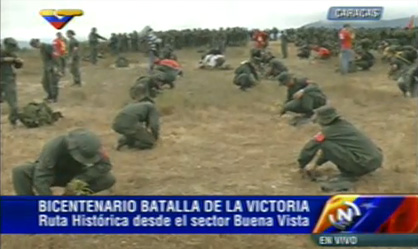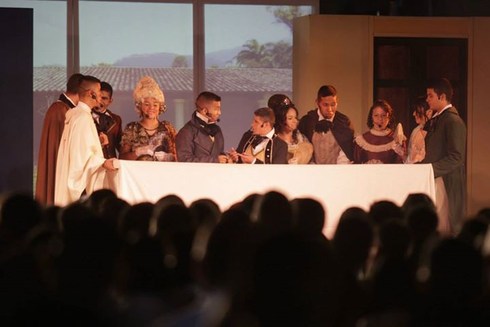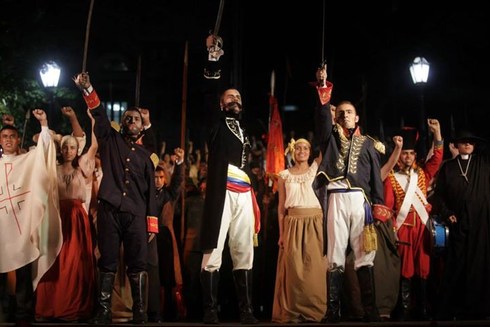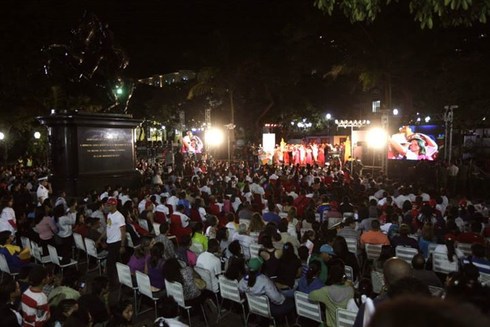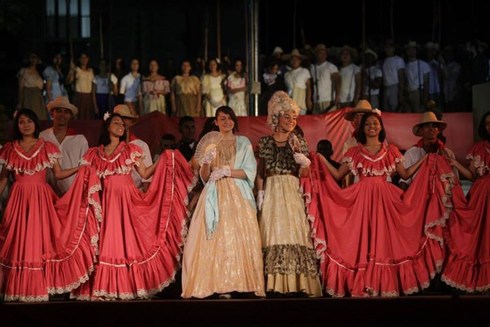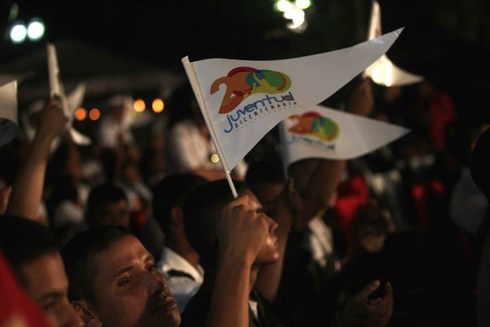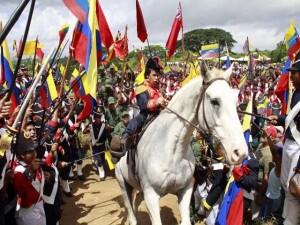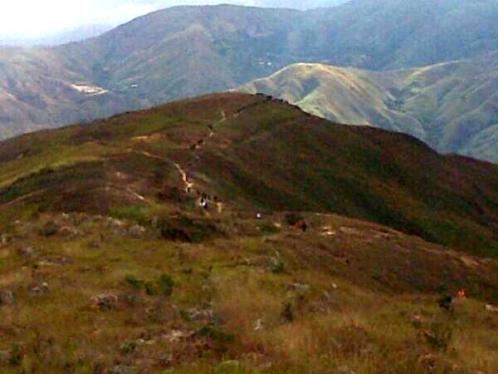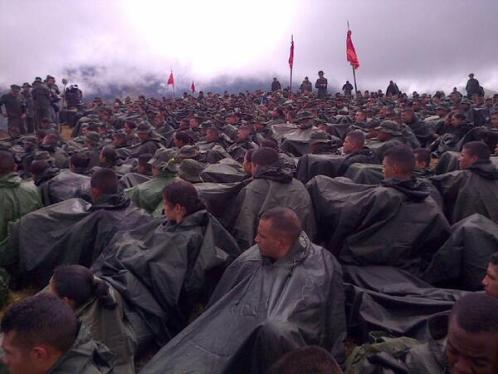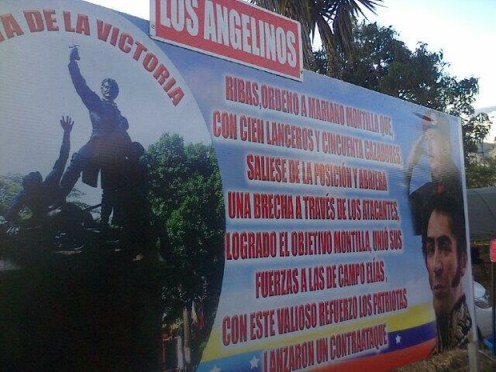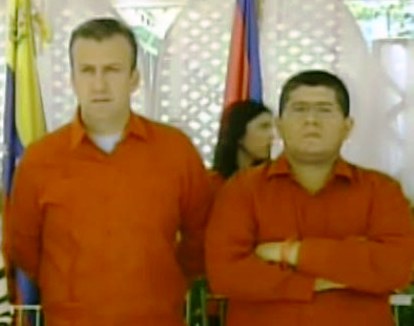| Introduction This is indeed an exciting week here in the City of La Victoria, State of Aragua, Venezuela. Axis of Logic Columnist, Arturo Rosales tells the story of why 650 Venezuelan military cadets are marching through the mountains all the way from Caracas to La Victoria, camping overnight along the way. Hundreds of young people are marching with them to re-enact an event that led to the defeat of the Spanish in the War of Independence. La Victoria has been preparing for months to greet them when they arrive and to begin celebrating the history that made famous this City of Youth. We are expecting their arrival here tomorrow or at the latest on Tuesday. A photo essay and video follow Arturo's essay. (Update: A total of 1125 marchers arrived here from Caracas today. We took lots of pics and plan to publish our photo essay of their arrival, the re-enacted battle, other of today's festivities and the big Youth Parade scheduled to take place on Wednesday.) - Les Blough in La Victoria In the context of the bicentenary independence celebrations in Venezuela which will cover the first cry for independence 200 years ago on April 19th 1810 and which ended on June 24th 1821 with the decisive Battle of Carabobo that forced the Spanish Empire out of the country, the Bolivarian government is celebrating all the important dates that were salient in the struggle for independence from Spanish imperialism that cost over half the lives of the then Venezuelan population.
Battle of La Victoria (02-12-1814) February 12th will be the 200th anniversary of the Battle of La Victoria (Aragua state) that saw Simón Bolívar’s cousin, José Félix Ribas, defend the strategic town of La Victoria against the superior military numbers of José Tomás Boves and his realist contingent. What was remarkable about this victory was that there was a shortage of patriotic troops to defend La Victoria to prevent the advance of Boves on Caracas and the resulting overthrow the infant 2nd Republic. The 2nd Republic was founded after Bolívar’s Admirable Campaign from Cartagena in New Granada (now modern day Colombia) to take Caracas winning battles all the way just six months earlier. In these circumstances José Félix Ribas, who was in Caracas when news of Boves’ advance on the strategic point of La Victoria reached him, was forced to recruit students and trainee priests from the Seminary of Santa Rosa de Lima (this is now an urbanization in 21st century Caracas) and march them to La Victoria, some 42 miles distant to cut off Boves’ advance. Ribas recruited 1500 young patriots, students and trainee priests with little or no military experience and headed off on a march, through the mountains to La Victoria which took three days. In La Victoria they set up defensive barricades to hold off the expected attack by Boves’ forces which numbered around 2500 troops. At that time there was no Pan-American Highway or paved roads to reach La Victoria from south-west Caracas and so the only route was over and through the mountain chain that extends from the coast to the fertile valleys of now Miranda and Aragua states. The route taken was originally an indigenous route and in 1814 was still named the Royal Path by the Spanish conquistadors. When the expected onslaught came by Boves at around 7am on the morning of February 12th 1814, the student patriots held out all day behind the defensive barricades and in the heat of the battle, Ribas is famously alleged to have yelled encouragement to his young troops saying: ”We can’t opt between dying and being victorious. It is necessary to be victorious. Long live the Republic.” At around 6pm the outcome of the battle had not been decided when the patriot General, Vicente Campo Elías, arrived with 220 cavalry which lent the necessary impetus to Ribas’ troops to repel Boves’ pressure and force the realists to retreat. This resulted in a hard-won victory for Ribas and his youth.
As a result the 1947 Constituent Assembly named February 12th National Youth Day with La Victoria as the City of Youth in honor of this vital defensive victory in preservation of the 2nd Republic. In modern day La Victoria the battle is honored by the existence of Plaza Ribas and Plaza Campo Elías (right in front of the Town Hall). José Félix Ribas was eventually betrayed and captured by the Spanish. His death was ordered on January 31st 1815 in Tucupido (Guarico state) where he was beheaded. His severed head was fried in oil and displayed in a cage at the Gate of Caracas in what is now La Pastora as a warning to other patriots. His untimely execution at the age of 39 deprived the patriotic independence movement of one of its key generals. Participatory Philosophy (and Democracy) In line with the political and cultural-historical policy of the Bolivarian government, there will be a celebration of the Battle of la Victoria and National Youth Day on February 12th both in La Victoria itself and in other cities including Caracas. One of the main features of the historical celebrations in Venezuela in the last 15 years since President Chávez first came to power on February 2nd 1999 has been the insistence in reviving, recreating and reliving history as Venezuelans. The purpose is to counteract the insidious transculturization of the country and its youth with totally materialistic US and Eurocentric values which are portrayed as somehow being “superior” to the historic “Venezuelanism” inherent in our ancestors, genetic make-up and collective historical memory. In the Blue Book of Hugo Chávez published after his death of March 5th 2013 and which is almost a prophesy of how the Bolivarian Revolution will progress in the next twenty years or so, Chávez talks about the key to understanding ourselves as Venezuelans and resolving any sort of problems are to be found by discovering them in our own history. This concept is not new and has been alluded to by great authors such as William Faulkner:
And T.S.Eliot
With history reinforcing the Venezuelan identity and transforming our outlook into one of national pride and collective strength - instead of one of feeling inferior to our “superior neocolonial masters” from the US and Europe, the Bolivarian Revolution will continue to advance with the population at the center of and benefiting from government and social policies, rather than the opposite of favoring the rich, the corporations and the banksters. Such is the case in countries that have long been touted as an example for the whole world to follow with their hollow representative democracy that is just a trap to deceive the population into thinking that it is “free”. Freedom is inherent in Venezuelan participatory democracy and brings the population nearer to the governmental decision making process rather than leaving everything in the hands of elected representatives. It is with this participatory aspect in mind that recreating and reliving history is part of the philosophy of “Chavismo” so as to learn from history and search for the key to problems in society and the country by consolidating the people’s link with it. In other words learn from the wisdom of the past and find recourse in the central tenet of Bolivarian philosophy which is the Tree of the Three Roots – Simón Bolívar, the General of the Sovereign People Ezequiel Zamora and Bolívar's mentor, Simón Rodríguez.
200 Years Later Besides a standard celebration of the Battle of La Victoria and National Youth Day, the Presidential Commission for February 12th 2014 decided to recreate the epic march on foot of Ribas and his seminarists through the mountains of Miranda and Aragua states on the same 42 mile route from south-west Caracas at the end of the metro line at Las Adjuntas, to the Plaza Ribas in La Victoria over three days.
The participants are 650 cadets of the Bolivarian Armed Forces (FANB), some 40 students and an untold number of citizens accompanying them in an active symbol of civic-military unity which is part of the lasting legacy of President Chávez to protect the Revolution. The march got underway from the Plaza Bolívar in Caracas and with the main contingent waiting at Las Adjuntas. The actual excursion to Aragua started in earnest on the morning of February 8th at around 7am. After a steep climb up the mountain the whole contingent stopped in a sector called Buena Vista where 200 oak and saman tress were planted by the cadets under the guidance of General Alexis Rodríguez Cabello.
In Venezuelan military terms these trees symbolize strength and fortitude; the number 200 represents the 200 years of The Battle of La Victoria and the idea of planting trees is encapsulated in the Tree Mission which has sown more than 7 million trees north of the River Orinoco since 2006. It is also part of Chávez’s legacy of everyone playing a small part (participation!!) to save the environment and therefore the planet before capitalism destroys it and the human race. The 42 mile route is replete with history from Spanish colonial times up to the Federal War of 1859 – 1864. Bolívar crossed the River Tuy several times on his independence campaigns and the Centaur and four times President of Venezuela, José Antonio Páez, greeted a US citizen in 1821 who was present on this historical trail. Páez was descending the mountain to Caracas with hundreds of lancers and troops in a long-drawn out column when they met by chance and Páez gave a cordial greeting to this stranger which he probably never forgot. The 2014 march led by General Alexis Rodríguez Cabello will cover 12 miles per days in mountainous terrain and will arrive in La Victoria on Monday February 10th, coming down from the mountain in El Consejo and then proceeding along the Pan-American Highway which leads directly into La Victoria and to Plaza Ribas in the town centre. We expect La Victoria to be overrun with people lining the streets to greet these 650 cadets and their civil counterparts into the city as the celebrations get underway for 200 years of history. People will really appreciate this recreation of history with it being relived by today’s youth in honor of the deaths and efforts of the patriotic youth of 1814 to protect the 2nd Republic and Bolívarps independence revolution from the reestablishment of Spanish imperial power in Venezuela. Finally and in the spirit of participating in history Axis of Logic is considering proposing to the Venezuelan Minister of Tourism, Andrés Izarra, the idea of creating an accompanied excursion from Las Adjuntos in Caracas to la Victoria so as to give others the chance of experiencing this historic march on a personal and collective level and inspire participants to seek the keys in history as recommended by President Chávez in his Blue Book. ¡Chávez vive, la Patria sigue!
READ MORE ANALYSIS AND ESSAYS BY AXIS OF LOGIC COLUMNIST, ARTURO ROSALES The first 7 photos portray the youth in Caracas who began festivities for the March to La Victoria with dramatic portrayals of revolutionaries who preceded them by 200 years, leaving them with a permanent revolution that began with the Great Liberator, Simón Bolívar. Photos of the march follow on.
On National Public Television (VTV), Pedro Márquez announced that the marchers who began their journey on Friday completed the first 17 kilometers on Sunday, arriving at Los Angelenos in The Valley of Fear (in Spanish) |



